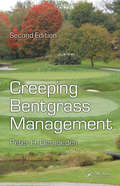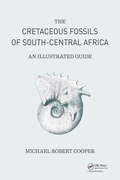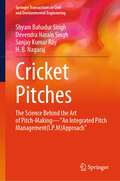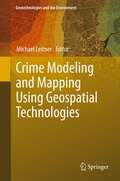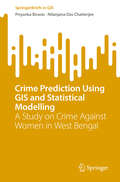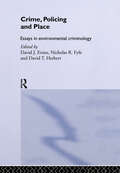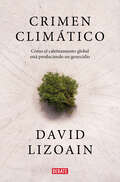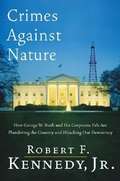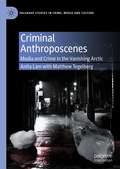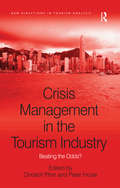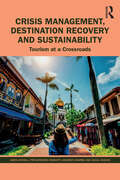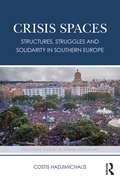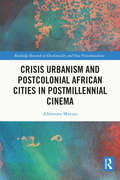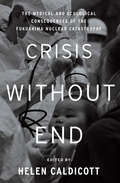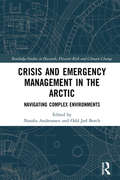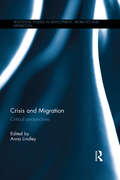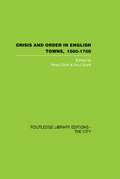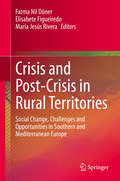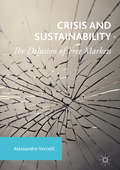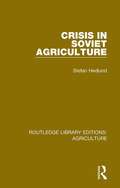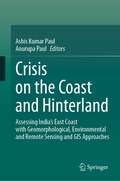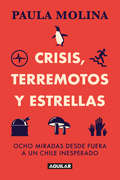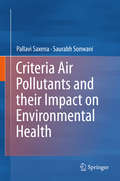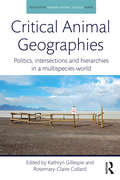- Table View
- List View
Creeping Bentgrass Management
by Peter H. DernoedenCreeping bentgrass is considered the premier turfgrass species grown on golf courses, and there is a growing demand for an understanding of its maintenance and management practices. Still the only comprehensive reference on the subject, Creeping Bentgrass Management, Second Edition helps you identify the factors that contribute to summer bentgrass
Cretaceous Fossils of South-Central Africa: An Illustrated Guide
by Michael Robert CooperThis book serves as an introduction to the Cretaceous geology and palaeontology of south-central Africa, covering the whole of Southern and Eastern Africa and Angola. Fifty two plates illustrate almost 1000 species and provide a field guide to the macrofossils of the subcontinent. The book will be of value to field geologists, students and non-specialists with an interest in the natural world. A bibliography of the Cretaceous palaeontology and stratigraphy of the subcontinent is provided. Features: Provides a concise account of the Cretaceous geology for 13 African regions Includes beautiful illustrations and a comprehensive bibliography Fossils are presented in stratigraphical order, allowing easy determination of the age deposits.
Cricket Pitches: The Science Behind the Art of Pitch-Making—“An Integrated Pitch Management (I.P.M) Approach” (Springer Transactions in Civil and Environmental Engineering)
by Devendra Narain Singh Shyam Bahadur Singh Sanjay Kumar Ray H. B. NagarajThe book develops a practical understanding of the fundamental scientific principles and logic underlying the art of turf pitch preparation, measuring, analysing, and interpreting pitch surface behaviour. It’s an attempt to understand how the captains, players, coaches, curators, and groundsmen comprehend and analyse the cricket pitch behaviour (days before and during the matches) and whether the pitch behaviour can be standardised and quantified (through bench marking or forming a data-based management system (DBMS) of a pitch profile, pitch quality standards, a pitch behaviour analysis index (PBAI), or pitch behaviour forecasting (PBF) by examining or analysing its mineralogical, chemical, physical, or morphological compositions, weather variables, and different pitch preparation methods and techniques. Individual chapters in this book deal with clay mineralogy, the bench-marking of cricket pitch soils, pitch soil chemical properties, pitch soil water, pitch turf grass, pitch soil organic matter, integrated rolling management, soil structure, and compressibility. This is an effort to decipher the impact of each and every major and minor component of pitch soil, which controls the pitch behaviour either in large or small magnitudes but acts as a critical factor in defining and shaping the pitch behaviour as a whole. Several real-life examples, pitch interviews, scenarios, and case studies as felt and observed by the curator( first author) during the preparation of various international, national, and board matches or during the construction and renovation of new wickets have been included in each and every relevant chapter so as to analyse, interpret, comprehend, and justify the theoretical science with the existing practises involved in pitch construction, preparation, or judging the complex nature of pitch behaviour. Based on findings through the DBMS, PBAI, and PQS of cricket pitch profiles, various innovative and simple methods of analysing, comprehending, and forecasting pitch behaviour have been devised that will enable one to judge and comprehend the complex pitch behaviour in simple ways.
Crime Modeling and Mapping Using Geospatial Technologies (Geotechnologies and the Environment #8)
by Michael LeitnerRecent years in North America have seen a rapid development in the area of crime analysis and mapping using Geographic Information Systems (GIS) technology. In 1996, the US National Institute of Justice (NIJ) established the crime mapping research center (CMRC), to promote research, evaluation, development, and dissemination of GIS technology. The long-term goal is to develop a fully functional Crime Analysis System (CAS) with standardized data collection and reporting mechanisms, tools for spatial and temporal analysis, visualization of data and much more. Among the drawbacks of current crime analysis systems is their lack of tools for spatial analysis. For this reason, spatial analysts should research which current analysis techniques (or variations of such techniques) that have been already successfully applied to other areas (e.g., epidemiology, location-allocation analysis, etc.) can also be employed to the spatial analysis of crime data. This book presents a few of those cases.
Crime Prediction Using GIS and Statistical Modelling: A Study on Crime Against Women in West Bengal (SpringerBriefs in GIS)
by Nilanjana Das Chatterjee Priyanka BiswasThe study presented in this SpringerBrief uses GIS tools to analyze incidents of violence against women in West Bengal India, identifying “hotspots” and offering tools and strategies to predict and prevent future violence. The aim of this study is to understand the existing scenarios and the complex crime patterns committed against women in West Bengal, using advanced GIS tools to map and understand the underlying socio-economic and physical environmental contexts of specific crime events, and critically discussed emerging criminogenic issues on the basis of theoretical understanding and immediate situations. This study evaluates the effectiveness of existing legislative measures to extract the gaps that exist between policy formulation and execution and effectively applied statistical methods and GIS technologies to visualize the future potential crime areas so that possible measures might be taken. The study considers four categories of violence perpetrated on women: human trafficking, acid attacks, rape and sexual harassment. Each chapter follows a self-contained design to address the study objectives as each crime follows distinct crime pattern, differentially affects the targets and increase risk of victimization and differential key factors are responsible for specific crime occurrences.
Crime, Policing and Place: Essays in Environmental Criminology
by David T. Herbert Nicholas R. Fyfe David J. EvansFirst published in 2002. Routledge is an imprint of Taylor & Francis, an informa company.
Crimen climático: Cómo el calentamiento global está provocando un genocidio
by David LizoainEl título de este libro no debería sorprendernos. Hoy toda política es política climática, y está en juego quién vive y quién muere. Estamos viviendo un momento decisivo para el planeta, que se encuentra al borde del colapso por culpa de las acciones humanas. En este fascinante ensayo de naturaleza optimista, aunque en ocasiones pueda parecer lo contrario, David Lizoain señala a los principales responsables de la actual emergencia climática y expone los puntos clave para un Green New Deal, ese indispensable proyecto de reestructuración económica masiva con el que lograríamos evitar el colapso y que culminaría en un nuevo régimen social y energético: el socialismo solar. Se espera que a lo largo de esta década vayan sucediéndose incontables desastres (pandemias, olas de calor, la pérdida de hábitats hasta ahora intactos, un descenso significativo de la biodiversidad...), algunos de los cuales ya han comenzado a desplegar sus terribles efectos. Estos no hacen sino confirmar la más que urgente necesidad de una transformación sin precedentes. ¿Podemos afirmar que lo que está ocurriendo es un genocidio climático? Es la pregunta que plantea Lizoain al inicio del libro. Su respuesta, clara y contundente, es que nadie más que el hombre, con su obsesión por el crecimiento perpetuo, ha abonado el terreno para la catástrofe. El nuestro es ya un mundo de eco-apartheid, y el genocidio climático tiene lugar gracias a la complicidad generalizada de los poderosos. Es hora de terminar con la impunidad, movilizarse y lograr una ruptura radical (y sostenible) con el statu quo.
Crimes Against Nature: How George W. Bush and His Corporate Pals Are Plundering the Country and Hijacking Our Democracy
by Robert F. KennedyIn this powerful and far-reaching indictment of George W. Bush's White House, Robert F. Kennedy, Jr., the country's most prominent environmental attorney, charges that this administration has taken corporate cronyism to such unprecedented heights that it now threatens our health, our national security, and democracy as we know it.
Criminal Anthroposcenes: Media and Crime in the Vanishing Arctic (Palgrave Studies in Crime, Media and Culture)
by Matthew Tegelberg Anita LamThis book compares and contrasts traditional crime scenes with scenes of climate crisis to offer a more expansive definition of crime which includes environmental harm. The authors reconsider what crime scenes have always included and might come to include in the age of the Anthropocene – a new geological era where humans have made enough significant alterations to the global environment to warrant a fundamental rethinking of human-nonhuman relations. In each of the chapters, the authors reframe enduringly popular Arctic scenes, such as iceberg hunting, cruising and polar bear watching, as specific criminal anthroposcenes. By reading climate scenes in this way, the authors aim to productively deploy the representation of crime to make these scenes more engaging to policymakers and ordinary viewers. Criminal Anthroposcenes brings together insights from criminology, climate change communication, and tourism studies in order to study the production and consumption of media representations of Arctic climate change in the hope of to mobilizing more urgent public and policy responses to climate change.
Crisis Management in the Tourism Industry: Beating the Odds? (New Directions in Tourism Analysis)
by Christof PforrAn important challenge facing tourism is the anticipation of the threat of crises precipitated by natural and people-made catastrophes, and being adequately prepared for them. Despite an increase in research on this issue there is still a considerable lack of clarity on the impacts of crises on the tourism industry. Illustrated by a range of international case studies, this book provides a systematic and conceptual approach to questions such as how tourism businesses prepare for and react to crisis, which measures are taken and what impact they have, and which strategies can be employed to overcome them. By discussing, analyzing and synthesizing the literature on crisis management, the authors question how business can become more proactive in preparing and dealing with crises in the tourism industry.
Crisis Management, Destination Recovery and Sustainability: Tourism at a Crossroads
by James Kennell Azizul Hassan Anukrati Sharma Priyakrushna MohantyThe COVID-19 pandemic brought travel to a halt and the global tourism industry has been one of the sectors hit hardest during the pandemic. This book looks at how the tourism industry can enhance its resilience and prepare for future crises more effectively. The book provides insights into the economic, social, geopolitical and environmental implications of the COVID-19 pandemic on the tourism and hospitality industries and the responses in diverse international contexts. It highlights key concepts and includes cases with real-life applications. The book also discusses future research directions in a post-pandemic scenario. This book will be an invaluable resource for practitioners in the areas of tourism and crisis management and for readers to compare and contrast tourism destination recovery and crisis management practices through different research methodologies and settings.
Crisis Spaces: Structures, Struggles and Solidarity in Southern Europe (Routledge Studies in Human Geography)
by Costis HadjimichalisThe financial malaise that has affected the Eurozone countries of southern Europe – Spain, Portugal, Italy and, in its most extreme case, Greece – has been analysed using mainly macroeconomic and financial explanations. This book shifts the emphasis from macroeconomics to the relationship between uneven geographical development, financialization and politics. It deconstructs the myth that debt, both public and private, in Southern Europe is the sole outcome of the spendthrift ways of Greece, Spain, Italy and Portugal, offering a fresh perspective on the material, social and ideological parameters of the economic crisis and the spaces where it unfolded. Featuring a range of case examples that complement and expand the main discussion, Crisis Spaces will appeal to students and scholars of human geography, economics, regional development, political science, cultural studies and social movements studies.
Crisis Urbanism and Postcolonial African Cities in Postmillennial Cinema (Routledge Research on Decoloniality and New Postcolonialisms)
by Addamms MututaThis book provides a framework to rethink postcoloniality and urbanism from African perspectives. Bringing together multidisciplinary perspectives on African crises through postmillennial films, the book addresses the need to situate global south cultural studies within the region. The book employs film criticism and semiotics as devices to decode contemporary cultures of African cities, with a specific focus on crisis. Drawing on a variety of contemporary theories on cities of the global south, especially Africa, the book sifts through nuances of crisis urbanism within postmillennial African films. In doing so the book offers unique perspectives that move beyond the confines of sociological or anthropological studies of cities. It argues that crisis has become a mainstay reality of African cities and thus occupies a central place in the way these cities may be theorized or imagined. The book considers crises of six African cities: nonentity in post-apartheid Johannesburg, laissez faire economies of Kinshasa, urban commons in Nairobi, hustlers in postwar Monrovia, latent revolt in Cairo, and cantonments in postwar Luanda, which offer useful insights on African cities today. The book will be of interest to students and scholars of urban studies, urban geography, urban sociology, cultural studies, and media studies.
Crisis Without End: The Medical and Ecological Consequences of the Fukushima Nuclear Catastrophe
by Helen CaldicottExpert essays provide the first comprehensive analysis of the long-term health and environmental consequences of the Fukushima nuclear accident. On the second anniversary of the Fukushima disaster, an international panel of leading medical and biological scientists, nuclear engineers, and policy experts were brought together at the prestigious New York Academy of Medicine by Helen Caldicott, the world&’s leading spokesperson for the antinuclear movement. This was the first comprehensive attempt to address the health and environmental damage done by one of the worst nuclear accidents of our times. A compilation of these important presentations, Crisis Without End represents an unprecedented look into the profound aftereffects of Fukushima. In accessible terms, leading experts from Japan, the United States, Russia, and other nations weigh in on the current state of knowledge of radiation-related health risks in Japan, impacts on the world&’s oceans, the question of low-dosage radiation risks, crucial comparisons with Chernobyl, health and environmental impacts on the United States (including on food and newborns), and the unavoidable implications for the US nuclear energy industry. Crisis Without End is both essential reading and a major corrective to the public record on Fukushima.
Crisis and Emergency Management in the Arctic: Navigating Complex Environments (Routledge Studies in Hazards, Disaster Risk and Climate Change)
by Natalia Andreassen and Odd Jarl BorchThis book sheds light on the management challenges of crisis and emergency response in an arctic environment. It explores how the complexity of the operational environment impacts on the risk of operations and addresses a need for tailor-made emergency response mechanisms. Through case studies of the arctic environment, the book illustrates how factors such as nature, geography, demographics and infrastructure increase the complexity of crises in the Arctic and present a significant danger to life and health, the environment and values in challenging Arctic waters. The case studies lay a special focus on contextual factors including conflicting interests and different stakeholder groups, as well as the institutional platforms influencing crisis response and emergency management. They also explore the implications for the managerial roles, the mode of operations, and the structuring of the organizations responsible for the emergency response. The necessity to facilitate cooperation across organizations and borders and a need for organizational flexibility in large scale operations are also emphasized. Written in an accessible style, this book will make for a useful resource for undergraduate and postgraduate students of disaster and emergency management, as well as for professionals involved in emergency services.
Crisis and Migration: Critical Perspectives (Routledge Studies in Development, Mobilities and Migration)
by Anna LindleyCrisis and migration have a long association, in popular and policy discourse as well as in social scientific analysis. Despite the emergence of more nuanced and even celebratory accounts of mobility in recent years, there remains a persistent emphasis on migration being either a symptom or a cause of crisis. Moreover, in the context of a recent series of headline-hitting and politically controversial situations, terms like ‘migration crisis’ and ‘crisis migration’ are acquiring increasing currency among policy-makers and academics. Crisis and Migration provides fresh perspectives on this routine association, critically examining a series of politically controversial situations around the world. Drawing on first-hand research into the Arab uprisings, conflict and famine in the Horn of Africa, cartel violence in Latin America, the global economic crisis, and immigration ‘crises’ from East Asia to Southern Africa to Europe, the book’s contributors situate a set of contemporary crises within longer histories of social change and human mobility, showing the importance of treating crisis and migration as contextualised processes, rather than isolated events. By exploring how migration and crisis articulate as lived experiences and political constructs, the book brings migration from the margins to the centre of discussions of social transformation and crisis; illuminates the acute politicisation and diverse spatialisations of crisis–migration relationships; and urges a nuanced, cautious and critical approach to associations of crisis and migration.
Crisis and Order in English Towns 1500-1700: Essays In Urban History
by Peter Clark Paul SlackThis collection of essays in English urban history covers a period which has been called 'the Dark Ages in English Economic History', on which it directs a revealing light. The essays range from a discussion of the role of ceremony in the civic life of Coventry at teh end of the Middle Ages to the influence of war on London Merchant class at the end of the seventeenth century. This book was first published in 1972.
Crisis and Post-Crisis in Rural Territories: Social Change, Challenges and Opportunities in Southern and Mediterranean Europe
by Elisabete Figueiredo Fatma Nil Döner María Jesús RiveraThis book sheds light on the effects of the financial and economic crisis in a diverse set of countries of Southern and Mediterranean Europe. Drawing on case studies from Greece, Italy, Portugal, Spain, and Turkey, this book presents a broad and integrative perspective on the impact of the crisis in different rural territories, discussing the similarities and dissimilarities of those impacts together with the resilience strategies adopted in each context. The impacts of the crisis in rural restructuring processes are also taken in consideration in this volume. Based on diverse theoretical and methodological approaches, the book discusses the challenges presented by the new socioeconomic contexts emerging from the crisis, as well as the resilience strategies adopted in rural territories by old and new actors. The book compiles nine empirical chapters dealing with the different cases and a final chapter devoted to the discussion of the shared and dissimilar processes of rural change. This book is a useful and valuable resource for scholars and post-graduate students from different disciplines, such as rural sociology, geography, anthropology, regional planning and agricultural studies.
Crisis and Sustainability: The Delusion of Free Markets
by Alessandro VercelliThis book offers a novel interpretation of the Great Recession and the ensuing Euro Crisis as a consequence of the evolution of capitalism since the 1970s. Chapters argue that the neoliberal development trajectory pursued in recent decades is unsustainable, and posit that neither sound macroeconomics nor empirical data support the unqualified faith in free markets that inspired it. The book begins by providing a broad critical perspective on key concepts such as freedom, free market, free trade, globalisation and financialisation, before going on to analyse the long and deep recent crisis as a result of the neoliberal policy strategy adopted since the early 1980s. The alternative narrative outlined in the book provides insights into the policy strategy required to achieve a sustainable development trajectory.
Crisis in Soviet Agriculture (Routledge Library Editions: Agriculture #8)
by Stefan HedlundThis book, first published in 1984, analyses the institutions and decision-making processes that determined agricultural production in the Soviet Union. It addresses the crisis in Soviet agriculture of the early 1980s, examining the problems of low productivity, adverse natural conditions and an underdeveloped infrastructure. The book’s analysis of the ‘crisis’ focuses on the growing gap between demand and supply of agricultural produce, and the pressures on the government to alleviate the food shortages.
Crisis on the Coast and Hinterland: Assessing India’s East Coast with Geomorphological, Environmental and Remote Sensing and GIS Approaches
by Ashis Kumar Paul Anurupa PaulThis contributed volume assesses the state and future of India’s East Coast through a wide variety of chapters grouped by methodology and approach. Part I: Assessment through Geomorphological Approaches describes geomorphological diversities of the eastern shorelines of India, Coastal Modelling System- SMC and morphodynamics of Odisha coast, Paleo shorelines and beach ridge chenier formations of Subarnarekha delta, seasonal sediment budget of Chandrabhaga beachdune system, Beach stage and dune stage modelling Mandarmoni coast, drainage characters of South Andaman Islands, coastal foredune morphology and sediment of Odisha and West Bengal, Geo-archaeological pieces of evidence of ancient coastal environment, coastal sediment characters, beach ridge formation in the chenier coast, and geomorphological changes of ancient ports and harbours in the shoreline of West Bengal. Part II: Assessment through Environmental Approaches addresses various environmental assessment techniques of mangrove sensitivity to the sea level rise process in the Sundarban, land degradation of the hinterland drainage basins, the riparian environment of the coastal drainage basins, agricultural adaptability in response to climate variability in the coastal areas of West Bengal, forest degradations of the lateritic upland tracts, coastal tourism potentialities in Odisha and West Bengal, Climate variabilities and agricultural modifications in the hinterland areas of West Bengal districts, the tidal flat environment of Sagar Island, landforms and Geomorphosites for the promotion of Geotourism in South Andaman Perils of Premature Reclamation of Sundarban, marine litter in the coastal regions of West Bengal and Odisha on flora, fauna and humans, Ground water contamination due to saline water encroachment in coastal Andhra Pradesh and Spatio-temporal changes in the Hugli estuarine environment and coastal hazards and flood risk of southwestern Sundarban. Part III: Assessment through Remote Sensing & GIS Approaches uses the aforementioned techniques in service of exploration of monitoring health of Mangrove forest, Geomorphological analysis of the coral fringed coasts of Andaman, hydrological and morphological variations of Ichhamati Tidal estuary, multivariate analysis of coastal vulnerabilities, geography of tourism resources in Andaman group of islands, tourism climate index with application geospatial techniques, diversity of landscape ecology in the coastal blocks of Purba Medinipur, overwash vulnerability in Odisha coast, livelihood security index of the coastal communities, managing coastal squeeze response and wetland loss in the estuarine coastal tract of West Bengal, environmental effects of historical land reclamation process in the Sundarban, and emerging environmental problems of coastal urbanization in Digha, Kanthi, and Haldia.
Crisis, terremotos y estrellas. Ocho miradas desde fuera a un Chile inesperado.
by Paula Mariela Molina TapiaChile a través de los ojos de destacados investigadores de la universidad de Harvard. A pesar de su tamaño y distancia de los grandes centros académicos de Estados Unidos y Europa, Chile ha inspirado a investigadores extranjeros por diversos motivos. El paisaje, la cordillera, los océanos y nuestros cielos, así como nuestros terremotos; tanto los telúricos como los políticos, sociales y económicos, han sido materia de investigación. La destacada periodista Paula Molina estudió en Harvard, y desde allá se puso a pensar precisamente qué y cómo nos veían los intelectuales y científicos de esa famosa universidad. Fue así como decidió entrevistarlos para poder ver Chile a través de los ojos de otros. Hacerlo, dice, "es recordar que vives en un país que mira directamente hacia el centro de la galaxia. O que tiene la base y los registros más antiguos de la Antártica y con ello, una de las claves para entender si lograremos contener el avance del calentamiento global. " Escuchar las historias de estos "afuerinos", permite emplazar las ideas que tenemos sobre nosotros mismos: un país que vuelve a armarse después de enfrentar un terremoto devastador, o que todavía no logra disminuir las desigualdades que surgen en la primera infancia. Y también para ver Chile como un microcosmos para entender la globalización y la explosiva inequidad que genera en distintos países, o las amargas lecciones que dejó su tragedia política en 1973, y cómo ella se refleja en el presente y en otras situaciones donde hoy se tensionan al límite la fuerza de la democracia y sus instituciones.
Criteria Air Pollutants and their Impact on Environmental Health
by Pallavi Saxena Saurabh SonwaniAir pollution is a global hazard. Majority of the world’s population is affected by air pollution. Contamination of air is no more an only an atmospheric problem but now has become a health concern too. Under the Clean Air Act of 1971, a set of air pollutants are designated as criteria pollutants. These are suspected to be strongly harming the public health and the environment as compared to other primary and secondary pollutants. Globally, this category of air pollutants has been given less attention, only few studies have been reported in this area. This book begins with a short background on criteria air pollutants and their sources, sinks and chemistry. The chapters explore the detailed nature of primary pollutants criteria pollutants such as nitrogen dioxide, sulphur dioxide, carbon monoxide, particulate matter and lead. Their reaction mechanisms, climate change potency, environmental health effects on plants and human life are discussed. The book also covers secondary pollutants such as ozone. The book discusses ozone chemistry and its environmental health effects. This book act as a valuable tool for students in Environmental Science, Biological Science and Agriculture, as well as environmental consultants and professionals involved in air quality research and the application of air quality guidelines and advice.
Critical Animal Geographies: Politics, Intersections and Hierarchies in a Multispecies World (Routledge Human-Animal Studies Series)
by Kathryn Gillespie Rosemary-Claire CollardCritical Animal Geographies provides new geographical perspectives on critical animal studies, exploring the spatial, political, and ethical dimensions of animals’ lived experience and human-animal encounter. It works toward a more radical politics and theory directed at the shifting boundary between human and animal. Chapters draw together feminist, political-economic, post-humanist, anarchist, post-colonial, and critical race literatures with original case studies in order to see how efforts by some humans to control and order life – human and not – violate, constrain, and impinge upon others. Central to all chapters is a commitment to grappling with the stakes – violence, death, life, autonomy – of human-animal encounters. Equally, the work in the collection addresses head-on the dominant forces shaping and dependent on these encounters: capitalism, racism, colonialism, and so on. In doing so, the book pushes readers to confront how human-animal relations are mixed up with overlapping axes of power and exploitation, including gender, race, class, and species.
Critical Approaches to the Australian Blue Humanities (ISSN)
by Claire Hansen Maxine NewlandsThis interdisciplinary edited collection explores and analyses the field of the blue humanities through an Australian lens. The blue humanities is a way of understanding humanity’s relationship with water and manifestations of what is referred to as the ‘blue’ – reefs, oceans, rivers, creeks, basins, and inland bodies of water.In its scope, this collection emphasises both the importance of the local and the interconnectedness of Australia with global environmental concerns. It considers how we conceptualise watery spaces and shades of blue in a country where water is often marked by its absence, its ephemerality, its politicisation, and its dangers. Contributors from environmental history, environmental social science, political science, literary studies, creative arts, Indigenous Knowledge, education, and anthropology tackle various entanglements between the human, the more-than-human, and watery Australian spaces in modern culture. It is the first volume to offer a specific, dedicated focus on the intersections between Australian space and the blue humanities, and it offers a pathway for those wishing to explore, critique, and advance ideas around the blue humanities in both research and teaching.Directly contributing to a growing interdisciplinary field, this is the first book to comprehensively examine the blue in Australia, appealing to scholars, educators, and students working across the humanities and social sciences with an interest in the environmental humanities, ecopolitics, ecocriticism, the blue humanities, cultural geography, environmental history, and the role of place.Chapter 2 of this book is freely available as a downloadable Open Access PDF at http://www.taylorfrancis.com under a Creative Commons Attribution-Non Commercial-No Derivatives (CC-BY-NC-ND) 4.0 license.
